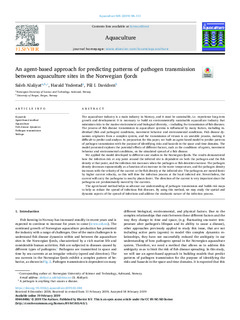| dc.contributor.author | Alaliyat, Saleh Abdel-Afou | |
| dc.contributor.author | Yndestad, Harald | |
| dc.contributor.author | Davidsen, Pål | |
| dc.date.accessioned | 2019-09-16T07:36:36Z | |
| dc.date.available | 2019-09-16T07:36:36Z | |
| dc.date.created | 2019-03-07T15:46:55Z | |
| dc.date.issued | 2019 | |
| dc.identifier.citation | Aquaculture. 2019, 505 98-111. | nb_NO |
| dc.identifier.issn | 0044-8486 | |
| dc.identifier.uri | http://hdl.handle.net/11250/2616886 | |
| dc.description.abstract | The aquaculture industry is a main industry in Norway, and it must be sustainable, i.e. experience long-term growth and development: It is necessary to build an environmentally sustainable aquaculture industry that minimizes risks to the marine environment and biological diversity, – including the transmission of fish diseases. The process of fish disease transmission in aquaculture systems is influenced by many factors, including individual (fish and pathogen) conditions, movement behavior and environmental conditions. Fish disease dynamics originates from a complex system, and the transmission of viruses is an unstable process, making it difficult to predict and analyze. In preparation for this paper, we built an agent-based model to predict patterns of pathogen transmission with the purpose of identifying risks and hazards in the space and time domains. The model presented explores the potential effects of different factors, such as the conditions of agents, movement behavior and environmental conditions, on the simulated spread of a fish disease.
We applied the model developed to different case studies in the Norwegian fjords. The results demonstrated how the infection risk at any point around the infected site is dependent on both the pathogen and the fish density at that point, and the infection risk increases when the pathogen or fish densities increase. The pathogen density decreases exponentially as a function of an increase in the water temperature, and the pathogen density increases with the velocity of the current or the fish density at the infected site. The pathogens are moved faster by higher current velocity, so this will slow the infection process at the local infected site. Nevertheless, the current will carry the pathogens to nearby places faster. The direction of the current is very important since the pathogens are predominantly moved by the currents.
The agent-based method helps us advance our understanding of pathogen transmission and builds risk maps to help us reduce the spread of infectious fish diseases. By using this method, we may study the spatial and dynamic aspects of the spread of infections and address the stochastic nature of the infection process. | nb_NO |
| dc.language.iso | eng | nb_NO |
| dc.publisher | Elsevier | nb_NO |
| dc.rights | Attribution-NonCommercial-NoDerivatives 4.0 Internasjonal | * |
| dc.rights.uri | http://creativecommons.org/licenses/by-nc-nd/4.0/deed.no | * |
| dc.title | An agent-based approach for predicting patterns of pathogen transmission between aquaculture sites in the Norwegian fjords | nb_NO |
| dc.type | Journal article | nb_NO |
| dc.type | Peer reviewed | nb_NO |
| dc.description.version | publishedVersion | nb_NO |
| dc.source.pagenumber | 98-111 | nb_NO |
| dc.source.volume | 505 | nb_NO |
| dc.source.journal | Aquaculture | nb_NO |
| dc.identifier.doi | 10.1016/j.aquaculture.2019.02.044 | |
| dc.identifier.cristin | 1683012 | |
| dc.description.localcode | © 2019 The Authors. Published by Elsevier B.V. This is an open access article under the CC BY-NC-ND license (http://creativecommons.org/licenses/BY-NC-ND/4.0/). | nb_NO |
| cristin.unitcode | 194,63,55,0 | |
| cristin.unitname | Institutt for IKT og realfag | |
| cristin.ispublished | true | |
| cristin.fulltext | original | |
| cristin.qualitycode | 1 | |

